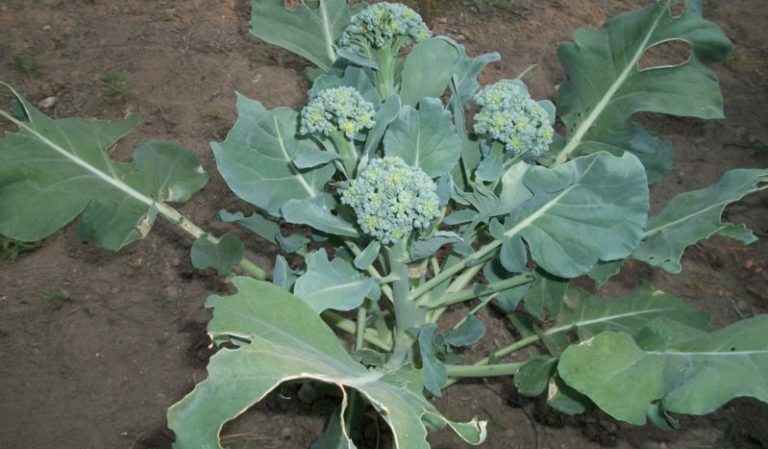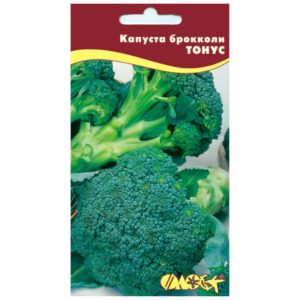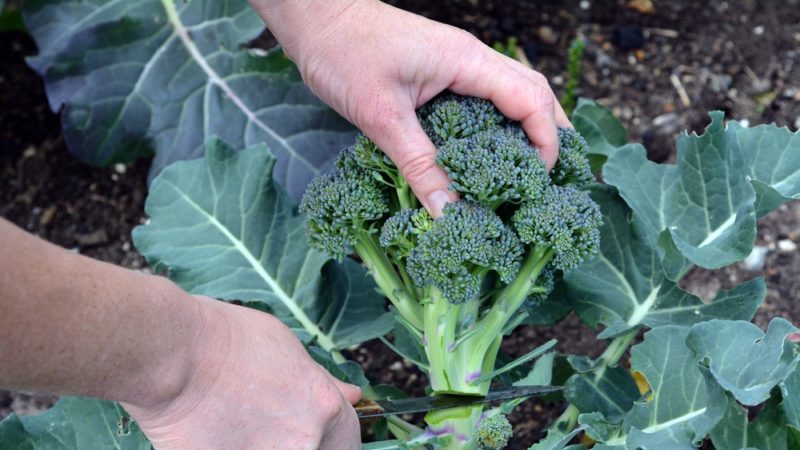Features of cultivation and description of the variety of broccoli cabbage "Tonus"
Tonus is a long-known variety of broccoli, which does not lose popularity among gardeners despite the emergence of new hybrids and varieties. It has minimal maintenance requirements and is not prone to flowering, gives a bountiful harvest several times per season and is characterized by a pleasant taste and juiciness of heads and stems.
The content of the article
Description of broccoli cabbage Tonus
The tone was brought out by domestic breeders. It is suitable for growing through seedlings or from seed by sowing in open ground.
Breeding history
Tonus was the result of the work of Russian breeders of the All-Russian Research Institute of Selection and Seed Production of Vegetable Crops.
The application for registration of the variety was filed in 1983, and in 1986 it was included in the State Register of Russia.
Chemical composition, trace elements and vitamins, useful properties

100 g of Tonus cabbage contain:
- selenium - 2.5 mcg;
- potassium - 316 mg;
- calcium - 47 mg;
- iron - 0.7 mg;
- phosphorus - 66 mg;
- magnesium - 21 mg;
- ascorbic acid - 89.2 mg;
- vitamin A - 31 mcg;
- B1 - 0.1 mg;
- B2 - 0.1 mg;
- B9 - 63 mcg;
- E - 0.8 mg.
Regular consumption of this vegetable prevents the accumulation of cholesterol and stagnation of bile, helps to improve the functioning of the gastrointestinal tract and cardiovascular system, and helps prevent heart attacks and strokes. Broccoli is healthy with gout, has a mild laxative effect.
Application features
Broccoli Tonus is consumed fresh, frozen, added to vegetable salads, omelets and soups, marinated, fried, stewed, steamed. This variety is suitable for canning, making snacks for the winter.
Boiled, mashed inflorescences are ideal complementary foods for babies.
Ripening period and yield
This is a variety with an early ripening period: the duration of the growing season after germination before the onset of technical maturity is 60-89 days.
Marketable yield - 0.8-1.5 kg per 1 m².
Reference. The crop is harvested up to 3 times per season.
Disease and pest resistance
The following pests and diseases can affect broccoli.
- aphid;
- fly larvae;
- fleas;
- whites and scoops;
- slugs and snails;
- blackleg;
- linen;
- powdery mildew;
- white rot;
- mosaic.
Cold resistance
Tonus tolerates a drop in air temperature to –7 ° C, but the optimum temperature for its growth and development is + 16… + 20 ° C.
Reference. At low temperatures, the heads turn brown.
Characteristics, description of appearance, taste
The plant is a small shrub with stems reaching a maximum length of 60-90 mm. Leaves are dark green, small, solid, petioled, slightly wrinkled, have a truncated ovoid shape and slightly wavy edges, covered with a bluish-gray waxy bloom of medium intensity. The length of the leaf plate is 9-14 cm, the width is 7-10 cm.

The heads are dark green, flat-round, of medium density, large (height - 8-10 cm, average weight - 162-200 g).
Blossoms Tonus in the first year of vegetation. During this period, small yellowish flowers appear on the plant, in the place of which, after flowering, fruits with seeds are formed.
The cabbage is juicy, has a pleasant, delicious taste with a slight bitterness.
Reference. The raw buds and stalks taste like asparagus.
Growing regions and climate requirements
Due to its unpretentiousness to climatic conditions, Tonus cabbage is suitable for cultivation in all regions.
Advantages and disadvantages of the variety
The main advantages of Tonus:
- excellent taste and rich chemical composition;
- early and amicable ripening;
- rapid regrowth of the axillary heads after cutting off the main one;
- the possibility of universal application;
- the formation of inflorescences even with a sharp drop in air temperature;
- high productivity;
- good transportability.
Cons of the variety:
- the release of sulfur and unpleasant odor during excessive heat treatment;
- short shelf life;
- the appearance of a brown tint with prolonged frosts;
- rapid flowering of buds with a lack of watering and intense solar radiation;
- a tendency to color.
Difference from other varieties and hybrids
Comparison of Tonus with other varieties and hybrids of broccoli in the table:
| Variety, hybrid | Ripening period | Head weight, g | Productivity, kg / m2 |
| Tone | Early | 162-200 | 0,8-1,5 |
| Vyarus | Early | Up to 120 | 2,9 |
| Caesar | Mid-early | Up to 135 | 2,5 |
| Fortune | Middle | 150 | 2,6 |
| Linda | Middle | 300-400 | 3-4 |
Features of planting and growing
Tone grow seedling, through sowing seeds under a temporary shelter or directly into the open ground.
Preparing for landing
For planting Tonus, they choose a sunny place, protected from cold and gusty winds. The plot is dug up in the fall and fertilized with compost and mineral fertilizers at the rate of 5 kg per 1 m².
If the seeds purchased in a specialized store are covered with a colored shell, additional processing is not required. Untreated or self-collected planting material is immersed in hot (+ 48 ... + 50 ° C) water for 5 minutes before sowing.
Seedless planting and growing from seeds
Seeds for seedlings are sown 35-40 days before transplanting plants into the ground. Prepare in advance containers for sowing with a depth of 5-7 cm with drainage holes and fill them with a nutrient substrate: a mixture of 1 part of turf soil, 2 parts of humus and a quarter of sand with the addition of ash and complex fertilizer, for example, Fertiki Lux. Sowing is carried out according to the scheme 1 × 3 cm, deepening the planting material by 1 cm.
Reference. In the case of preliminary germination, seedlings appear in 2-3 days, when sowing dry seeds - in a week.
After the emergence of seedlings, containers with seedlings are removed to the most illuminated and cool place - with an air temperature not higher than + 15 ° C. When 1 true leaf is formed on the plants, the cabbage is planted in individual containers.
7-10 days before transplanting seedlings into the ground, they begin to harden and accustom them to the sun. To do this, containers with plants are taken out into the street, first for 1-2 hours, and then for the whole day.
For seedless cultivation, seeds are sown in the ground in May - June according to the scheme 50 × 50 cm, placing 3-5 seeds in one planting hole.
In the case of planting in open ground, the seeds are sown densely, and when the seedlings begin to press against each other, they choose the strongest plant, and pinch the rest.
Covering material is used to protect young plants from drying out, frost and pests. The most convenient option is agrofibre on arcs.
Ground requirements
Variety Tonus prefers a nutritious soil with aeration, moisture permeability and weak or neutral acidity.
Timing, scheme and landing rules
Seedlings are transplanted into the ground when 3-4 leaves are formed on it. In central Russia, it is about May 10-15.
Landing Algorithm:
- Form in the selected area rows at a distance of 35-40 cm from each other.
- Every 45-50 cm, dig planting holes in them, the depth of which corresponds to the size of the roots of the seedlings.
- Fill the wells with water with the addition of Fertiki Lux or BioHumus (1 tbsp. L. Or 30 ml per 10 l of water, respectively). This promotes better survival of the seedlings.
- After absorbing water, remove the plants from the containers, place them in the planting holes and sprinkle with earth.
- Pour clean water over each bush under the root.
- Mulch the soil in the beds with cut grass or straw.
The nuances of outdoor care
Immediately after planting, the plants are watered once every 7 days. When the air warms up to + 25 ° C and above, the frequency of watering is increased to 2-3 times a week.
Reference. Cabbage is watered in the evening at the root, and the foliage is sprayed.
Fertilizers are applied according to the scheme:
- 2 weeks after planting seedlings in the ground - mullein solution (1 tbsp. per 10 liters of water + 1 tsp. urea);
- after 2-3 weeks - a solution of nitrate (2-3 tablespoons per bucket of water);
- August - potassium-phosphorus fertilizers ("Nitrofoska", "Autumn");
- after harvesting - dressing for side branches (10 g of saltpeter, 20 g of phosphate, 30 g of potassium per 10 liters of water).
Before wintering, 1 tbsp is applied for every 1 m² of land. l. ash.
Disease and pest control
Diseases and pests dangerous for Tonus are presented in the table.
| Pest / disease | Signs | Treatment |
| Aphid | The leaves are curved, take on a domed shape. | Processing of foliage with soap or ash-tobacco solutions. |
| Fly larvae | The gouged entrances on the stems, roots and heads are noticeable. | Treatment with the "Ambush" preparation. |
| Fleas | Plants dry out and die because of the tunnels gnawed in the shoots. | Plants are treated with infusion of tansy and celandine, pollinated with sifted ash and sprayed with insecticides (Actellik). |
| Whitefish and scoops | Butterflies lay eggs on the underside of leaf plates, caterpillars gnaw through leaves and heads of cabbage, leaving behind a dark green discharge. | Chemicals are used, for example, "Foksim" or "Ambush". |
| Slugs and snails | Pests damage the roots and aerial parts of cabbage, leaving behind a noticeable silvery mucus. | The aisles are sprinkled with tobacco and ground pepper. |
| Blackleg | Softening and blackening of the neck. | For prevention, the plant is treated with a weak solution of potassium permanganate. |
| Belle | Dark spots appear on the stem and pedicel. | Infected bushes are cut out, and healthy ones are treated with copper sulfate. |
| Powdery mildew | A white powdery coating forms on the leaves. | Three times ash processing with an interval of 7 days. |
| White rot | Rotting shoots, the appearance of plaque on the inside of the leaves. | Prevention consists in the introduction of nitrogen fertilizers into the soil. Treatment involves the treatment of plants with copper-containing preparations ("Kuprikol", "Zoltosan"). |
| Mosaic | The leaves brighten, wrinkle, point spots appear on them. | The infected bushes are dug up and thrown away, the rest are treated with Aktara or Aktellik. |
Growing difficulties
Cultivation of Tonus can be fraught with some difficulties:
- heads are not formed - the plants did not have enough moisture;
- the heads are small and bloom quickly - insufficient watering during the laying of inflorescences;
- the heads turn brown - prolonged exposure to low temperatures.
Harvesting and storage
The broccoli heads are cut off before they bloom. Flowers that are soft, ready to open, indicate that it is time to harvest.

How and when to collect
When Tonus is grown by seedlings in central Russia, the crop is harvested from the end of June until the onset of frost.
The heads are cut off with a sharp knife, leaving a leg 5-7 cm long.
Storage features
The harvested crop is eaten or processed as soon as possible. Broccoli heads packed in paper or film are stored in the refrigerator for no longer than 5-7 days.
Advice and feedback from experienced gardeners
Farmers recommend:
- follow the rules of crop rotation and plant Tonus after potatoes, onions, carrots, pumpkins, legumes and cereals;
- water the plantings regularly, otherwise the crop will be poor and of poor quality;
- it is imperative to add lime or nitrogen to the soil if its acidity is increased, otherwise the plants will grow slowly and hurt.
Most reviews about Tonus broccoli cabbage are positive.
Irina, Moscow region: “We plant broccoli every year. Usually several different varieties, including Tonus. Our family fell in love with it because it ripens early enough, and even the crop can be harvested several times per season. True, after the first cut the heads are formed small, but quickly. "
Valentina, Bryansk: “We plant tonicity more often than other broccoli varieties. He likes the fact that he does not need special care, and the crop gives 2-3 times. The first heads grow about 15 cm, small ones are formed from the stepchildren, but even in late autumn there is fresh cabbage on the table ”.
Conclusion
Broccoli Tonus has many positive characteristics: intensive regrowth of axillary heads, excellent taste, benefit, early and amicable ripening, high yield and good transportability. At the same time, the variety is not picky about care, so even novice gardeners can cope with its cultivation.